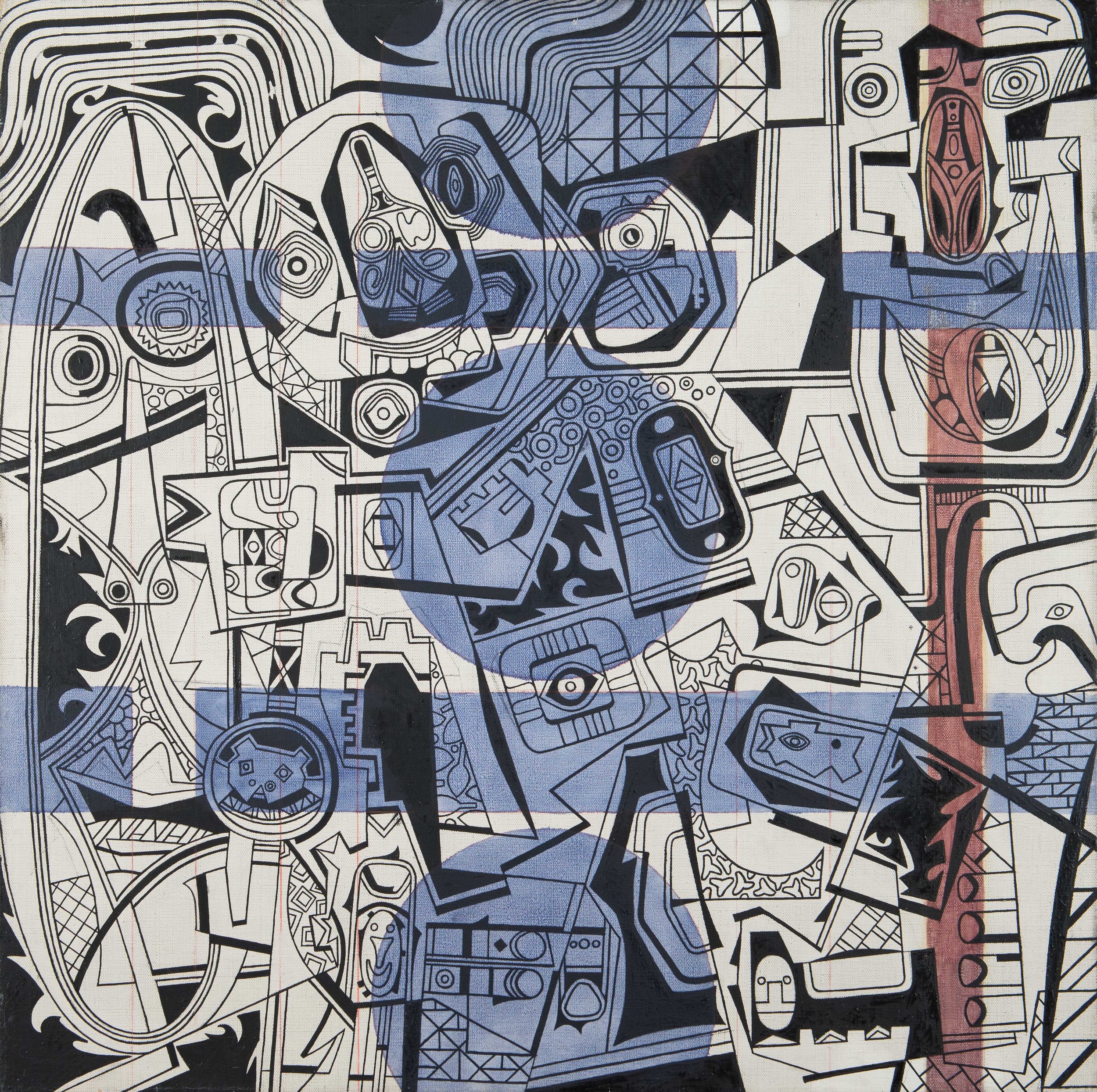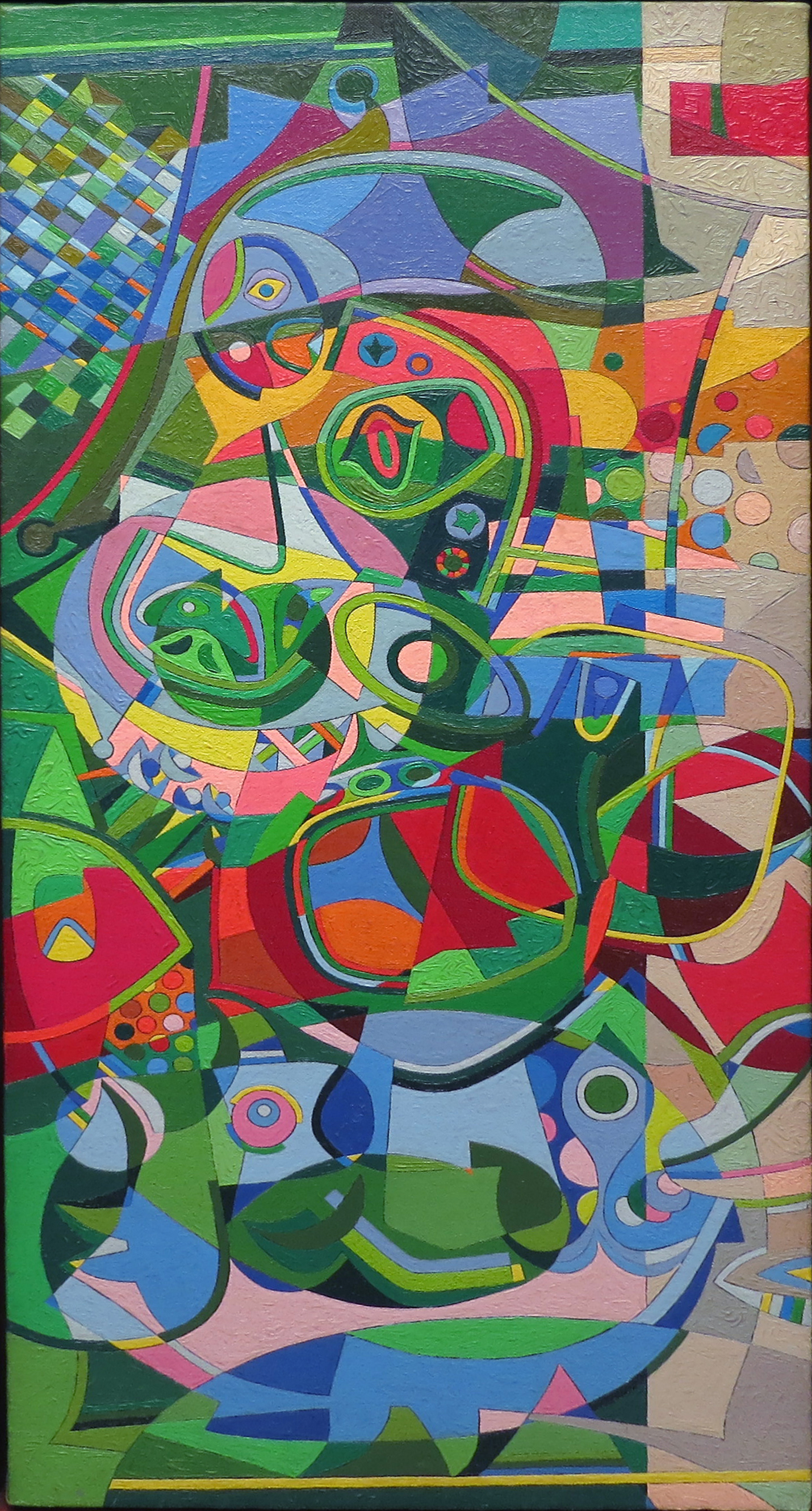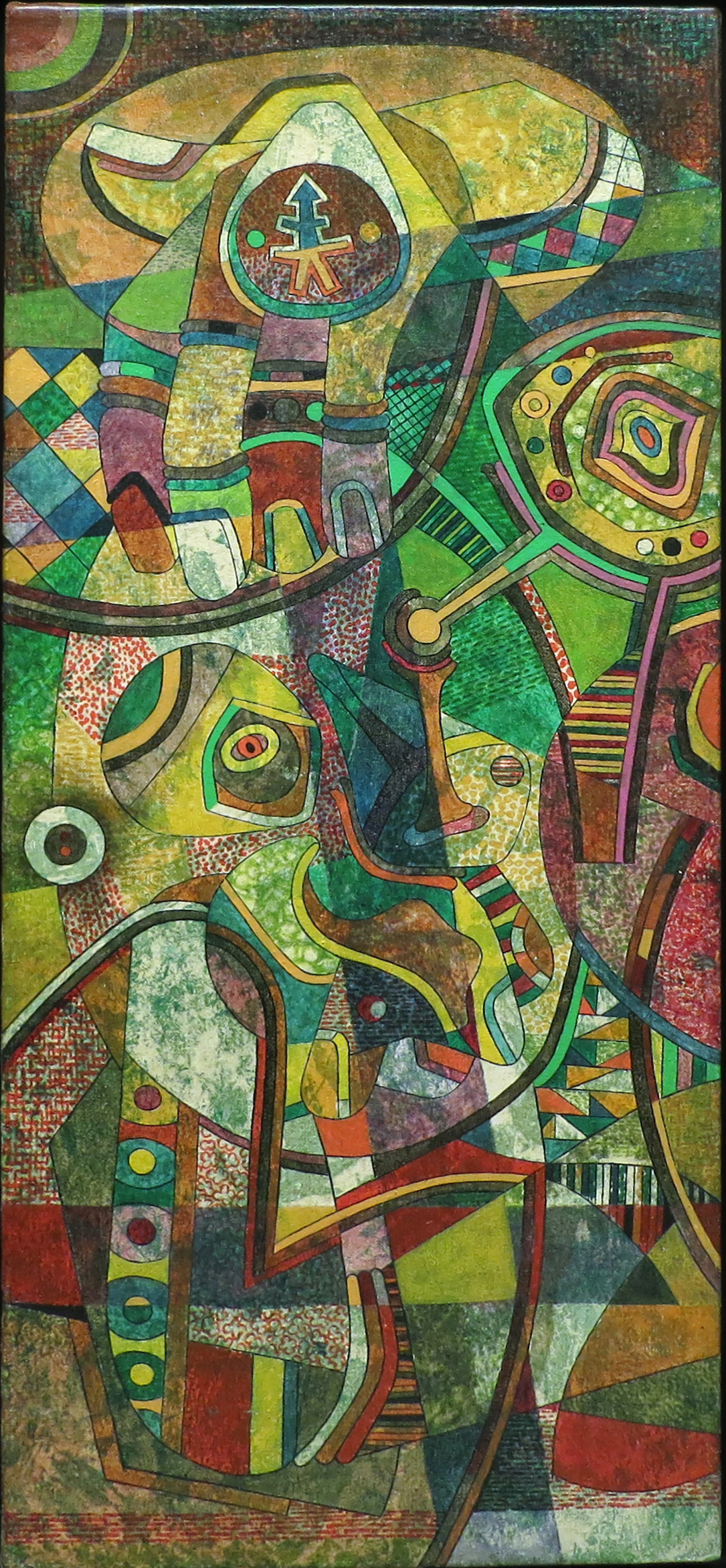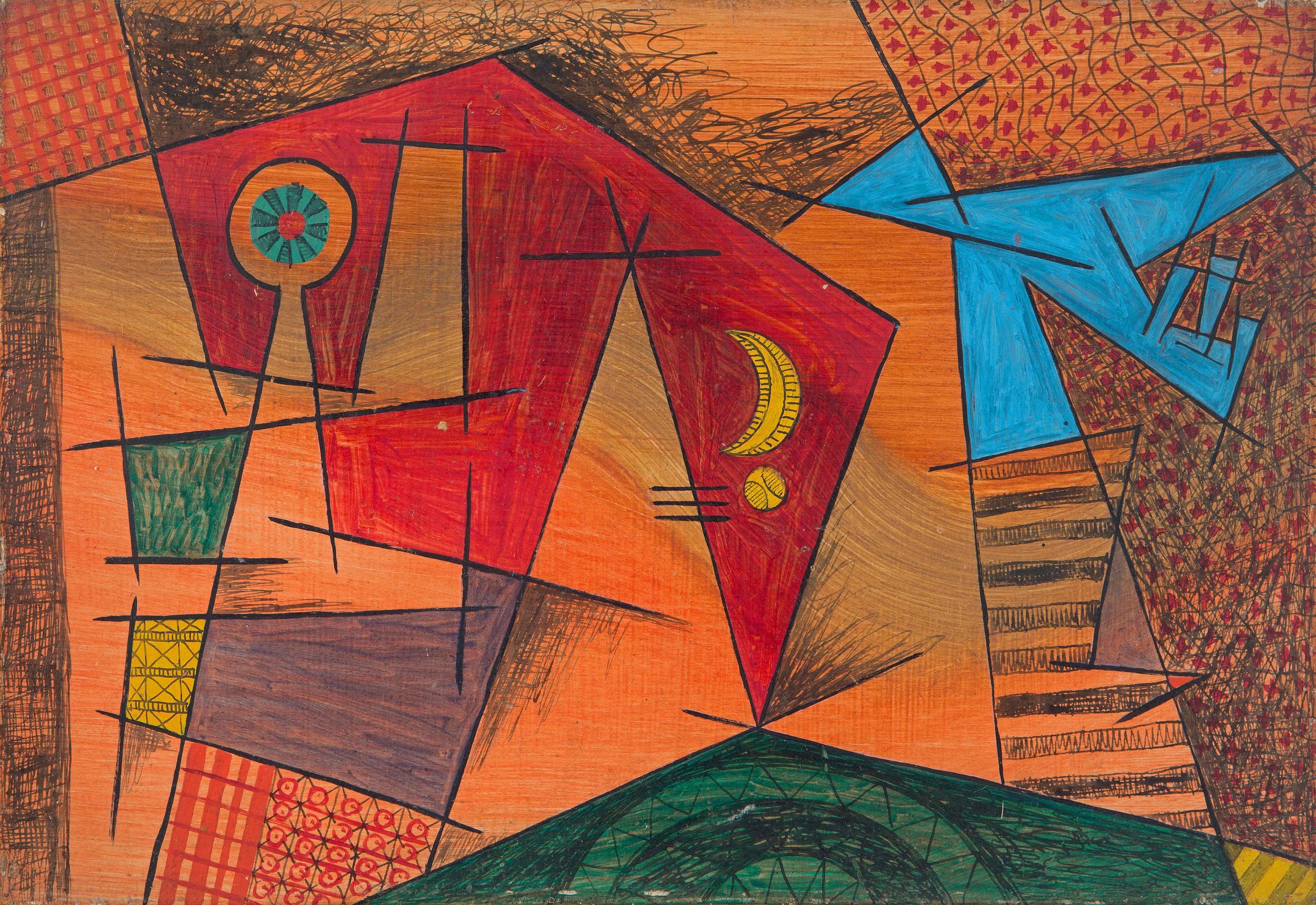Steve Wheeler (1912-1992)
About Steve Wheeler
Artist, author, and visionary Steve Wheeler was born Stephen Brosnatch in Slovakia and emigrated with his family to New Salem, Pennsylvania, when he was a young boy. Leaving school at sixteen to work in the coalmines with his father, Wheeler continued to read and study voraciously. His readings on art were a particular passion, and he soon determined to leave the mines to become an artist. He left Pennsylvania for Chicago to study with his uncle, a commercial illustrator, and probably also took art classes at the Art Institute of Chicago. In 1931 he moved to Pittsburgh, where he may have continued his training at the Carnegie Institute. In 1932 Wheeler began studies in New York at the Art Students League and with Hans Hofmann, under whom he developed his own theories of space in painting. Hofmann played an integral role in shaping Wheeler's ideas about art, emphasizing the importance of Cubism, abstracting from nature, two-dimensionality and the push-pull of positive and negative space. Hofmann's ideas were a revelation for Wheeler, but ultimately he became dissatisfied with simply reworking the ideas of older artists. He wanted to expand on the Cubists' concept of space and needed a new pictorial language with which to do so.
In order to develop his own ideas, Wheeler withdrew to Pittsburgh in 1939. He had married Elsbet Margot Peterson earlier that year and living in Pittsburgh proved to be less of a financial burden for the young couple. In Pittsburgh, Wheeler felt a greater freedom to define his artistic identity. He remained in close contact with fellow League students Peter Busa and Robert Barrell, and in 1940 he returned to New York, drawn by the active art community and developing trends in European and American modernism.
Wheeler's ideas about art continued to germinate in the fertile milieu of New York in the early 1940's, and in 1940-41 he produced his first mature work. These small panels display Wheeler's innovative assimilation of a variety of sources, including Cubism, Surrealism and American Indian art. In particular, Wheeler was drawn to the work of Paul Klee and Joan Miró, whose paintings were shown in two separate exhibitions at the Museum of Modern Art in 1941. Also in 1941, the Modern mounted the landmark exhibition India Art of the United States. This was among the earliest efforts to display and interpret Native American art outside the confines of an ethnographical or anthropological museum, and marked the broad acceptance of these tribal works as art objects rather than archaeological artifacts. As a result, interpretations of American India and Pre-Columbian art and culture, once the province of specialists in the field, were not made accessible to the general public.
Wheeler and his friends Barrell and Busa had begun to visit collections of tribal art at the American Museum of Natural History, the Brooklyn Museum, and the Heye Foundation as early as 1937. By the early 1940s, Wheeler had found the ideal visual language for his work in the art of the Northwest Coast Indians, an ideographic art in which image, symbol and myth came together. The idea of appropriating primitive forms in modernist painting was certainly not new. Europeans and Americans from Pablo Picasso to Marsden Hartley had incorporated such imagery into their paintings earlier in the century. Wheeler's approach to primitive art was more closely aligned with that of Paul Klee, whose ideas on nature and abstraction, fantasy, and the subconscious were enormously influential to him. By the early 1940s, however, Wheeler, along with many of his contemporaries, began to take their study of Native American art further than earlier generations of artists by reading anthropological texts and attempting to understand its formal and symbolic principles.
Through the work of anthropologist Franz Boas, Wheeler learned that the characteristics of Northern Coast Indian art included stylization, exaggeration of anatomical features, and splitting and dislocating forms to cover an entire surface. He also discovered how metamorphosis (for example, a man turning into a fish) could function simultaneously as historical narrative and potent symbol. Wheeler adapted a linear stylization of forms similar to the tribal Northwest Coast art for his own use. He developed a linear stylization of forms similar to the tribal works. He created a language of symbols and pictographs. He explored the idea of metamorphosis, transmuting his figures within one composition or altering the figure from one painting to the next. Finally, muting his figures within one composition or altering the figure from one painting to the next. Finally, he gave equal weight to positive and negative space and eliminated any differentiation between foreground and background. This last element, characterized by the flattening of the picture plane and an allover design, came to be known as Indian Space painting, and became the common philosophy for the artists who joined the Indian Space Painters group.
Wheeler was linked with the Indian Space painters at the height of his career during the 1940s and 1950s. The group was a loose federation of New York artists offering an alternative to the emerging Abstract Expressionists. Wheeler pioneered this movement, though he consistently denied being a member of the group. Expanding the visual language of American modernism through the exchange and synthesis of ancient and modern mythology, art, and ideas, Wheeler and the Indian Space Painters—Will Barnet, Robert Barrell, Peter Busa, Gertrude Barrer, and others—made richly colored, intricately patterned works.
While American Indian art served as Wheeler's formal framework and was the philosophical foundation upon which he built his theories, it was by no means his only source. Other visual sources for him included American folk art, Slovak folk art, children's art, decorative patters, cartography, mechanical drawing, and calligraphy. Wheeler deftly combined his own formal language with decorative patterns and calligraphic lines. His synthesis of these various sources resulted, by 1942-43, in a highly individualized form of abstraction. Yet, while he contributed to the trend of 1940s abstraction, Wheeler insisted that his work was always profoundly representational, figuring his life experiences in potent combinations of forms.
Wheeler used historical, mythological, and literary sources for his paintings, but he often found his subjects in contemporary culture: movies, radio shows, popular songs, jazz, and advertising. He also used fragments from his own life and experience—magazine clippings, visual and linguistic puns, catchy phrases, people he know—distilling them through the veil of his unconscious to create his fanciful and fantastic compositions. From these sources, and from his own reading, study, and experience, Wheeler created his own archetypal characters specific to the era in which he lived. Wheeler's characters, such as the Traveler (Odysseus), the Sheik, Leon, and Little Joe, appear again and again in his compositions. They become symbols within Wheeler's own language, signifying a universal truth or concept.
In 1947 Wheeler produced Hello Steve, a limited edition book of silkscreen prints and essays that expressed his highly personal artistic theories. The subjects of the prints included several of these archetypes that recur in his paintings, drawings, and writings.
A notebook in the Steve Wheeler estate archives shed some light on Wheeler's process. It contains a list of titles for works, or perhaps themes to explore. The list has the feel of automatic writing, as if he wrote down one idea that, in turn, brought to mind another, and another. Wheeler was aware of the work of Carl Jung and his idea of the universal unconscious, and perhaps these lists were part of his attempt to access his primordial self. Certainly his paintings reflect his effort to create contemporary archetypes filtered through the lens of the artists' mind. Whether Wheeler came up with his titles prior to producing a picture or vice versa is unclear. What is certain is that these were the themes that captured his intellect and that resurfaced often in his work as totemic icons.
Wheeler was not alone in attempting to tap into the universal unconscious through the use of symbols. Contemporaneously, the nascent Abstract Expressionists were undertaking similar experiments. But unlike such artists as Adolf Gottlieb from Jackson Pollock, whose work reflected a sense of primeval terror and postwar anxiety, Wheeler's world view was essentially positive, optimistic, and often humorous.
Wheeler continually struggled to portray himself as a unique artist unrestricted by current trends and movements in modern art. He was contemptuous of the art world upon which he depended for publicity and success. Unfortunately, this impulse tended to isolate him, limiting his opportunities to exhibit work that, when shown, received favorable reviews.
Wheeler was a man of his times. His work is a crystallization of the many ideas and theories that were in the air at the time and which affected an entire generation of artists. He has an insatiable thirst for knowledge and was fascinated by many different fields, from art to anthropology to psychoanalysis, and dipped into each of these areas to take what he needed to create his art. From his earliest experiences as a young man in the Pennsylvania coalmines, Wheeler felt it was his destiny to become an artist, and he followed that path single-mindedly. Now, after decades of anonymity, Wheeler's pictures have again gained attention as an important yet long overlooked moment in the development of twentieth-century American art.




